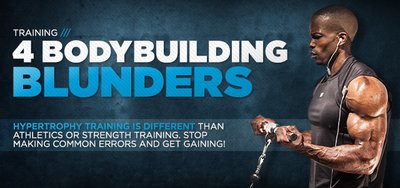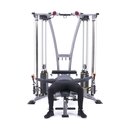Over the years I've had the honor of training a multitude of physique athletes who were looking to gain size. In doing so, I've had to continually cultivate and refine my training concepts and techniques to help them achieve more success. After all, hypertrophy training is fundamentally different in some ways than athletic or strength training, and pretending it isn't leads to subpar results.
That said, the line isn't always clear, and I've made some mistakes myself. Having the discipline to embrace them and learn from them was valuable. If you're going to hang around in the training game for long, you'll make mistakes, too.
Sorry, that's just the way it is.
Does that mean you should just wait until you know you're wrong to change your ways? Of course not. I'm going to share four of the biggest bodybuilding workout mistakes that I see being made—even by personal trainers—on a regular basis. Address them with the simple training solutions I provide, and you'll get better results, plain and simple.
1. Resting Too Long Between Sets
One of the most popular methods of weightlifting is to use paired sets like these:

BodyFit
$6.99/month- 2,500+ expert-created single workouts
- 3,500+ how-to exercise videos
- Detailed workout instruction
- Step-by-step workout tips
- Training at gym or at home
- Access to Workout Plans
- Access to Bodyfit App
- Store Discounts
Already have a Bodybuilding.com account with BodyFit? Sign In

What comes with BodyFit?

- Instructional Videos
Don't risk doing a workout improperly! Avoid injury and keep your form in check with in-depth instructional videos.

- How-to Images
View our enormous library of workout photos and see exactly how each exercise should be done before you give it a shot.

- Step-by-Step Instructions
Quickly read through our step-by-step directions to ensure you're doing each workout correctly the first time, every time.
This paired set method is used to get more done in the time you have at the gym. And, it's also done to increase rest time between sets.

{{caption}}
Why It's a Mistake: When the goal is to increase strength or power—i.e. improve motor unit recruitment—I'm all about paired sets and trisets done in the fashion displayed above. But when it comes to training for mass, paired sets done in the above fashion aren't generally as effective as the traditional single set method or superset method.
The general scientific consensus, to which I can attest based on years of empirical evidence, is that the optimal rest intervals between sets for maximal hypertrophy gains is around 30-90 seconds. If we look at the above example of a paired set and assume each set of bench press and bent-over rows take 30 seconds to complete, that translates into 150 seconds (2-1/2 minutes) of rest before you return for your next set of bench press.
This is almost three times higher than the upper limit of the ideal range. The rest interval between each exercise gets even further extended when you throw in unilateral exercises. You've got to count the time it takes to do both sides.
Even if you stick with this paired set strategy and cut your rest interval between exercises in half, to only 30 seconds, it still puts you at 90 seconds rest between sets of the same exercise. This is pushing at the upper end of the range for maximizing your muscle pump and potential size gains. Plus, you're going to go into each set tired, because you're only 30 seconds out of a hard effort, so it's certainly going to interfere with your overall working intensity at each set.

{{caption}}
The Solution: If your training split calls for, let's say, a chest and back day, try focusing the first half of the workout on the back, and the other half on the chest. At Performance University, we do this instead of pairing chest and back moves, so we can more accurately stick with a 30-90 second rest interval between exercises that focus on the same muscle group.
If a program calls for a chest/shoulders/triceps day, I emphasize the good old single set method with compound movements. I like to save supersets for isolation-type exercises, because I've found that physique athletes can transition between two isolation moves with little rest. These exercises are less fatiguing than compound movements.
Here's an example of this superset strategy for an isolation exercises on a chest/triceps emphasis training day:

BodyFit
$6.99/month- 2,500+ expert-created single workouts
- 3,500+ how-to exercise videos
- Detailed workout instruction
- Step-by-step workout tips
- Training at gym or at home
- Access to Workout Plans
- Access to Bodyfit App
- Store Discounts
Already have a Bodybuilding.com account with BodyFit? Sign In

What comes with BodyFit?

- Instructional Videos
Don't risk doing a workout improperly! Avoid injury and keep your form in check with in-depth instructional videos.

- How-to Images
View our enormous library of workout photos and see exactly how each exercise should be done before you give it a shot.

- Step-by-Step Instructions
Quickly read through our step-by-step directions to ensure you're doing each workout correctly the first time, every time.
2. Avoiding Machines
I'm not into the "never use machines" mindset of many other personal trainers. Especially when the goal is to gain muscle size, I feel it's a huge mistake to avoid using strength training machines, because when used properly they offer some distinct benefits.
Why It's a Mistake: All free weights involve a single load vector, which is gravity, to create resistance. If you use a cable machine, you're also working against a single load vector, which is the line of the cable itself. Any time you work against a single force vector, you're going to have ranges within the exercise where the lever arm is long, creating high levels of muscle activation; and ranges where the lever arm is short, resulting in little activation.
On the other hand, machines are designed with a cam setup, which isn't dependent on a single load vector. Instead, the cam is designed to provide you with consistent resistance throughout the entire range of motion, which translates into increased time under tension. You don't get a chance to rest at the bottom or top position like you can with most free-weight exercises.
Think of a biceps curl or triceps rope press-down. As you bring the weight closer to the end ranges of those exercises, you get much less work—sometimes almost none.
On the other hand, the biceps curl machine's cam enables it to adjust the force vector accordingly to create high-levels of muscle activation through the entire range of motion.
The Solution: It's simple. For both physique and performance-oriented athletes, I prefer to use free weights for compound lifts and mix and match cam machines, free weights, and cable exercises applications when we're doing less-complex, single-joint type movements.
Both types of exercises have advantages, so don't let popular misconception blind you to machines' unique muscle-building benefits.
3. Not Doing Enough Sets
There's a trend in the strength and conditioning world to classify upper-body exercises as either horizontal or vertical "pushing and pulling" actions. Likewise, lower-body exercises tend to get labeled either "knee-dominant or hip-dominant."
I don't mind this classification system as a way to make sure you include one exercise for each basic movement pattern for general strength and athletic conditioning. It's also great for beginners to ensure their program is covering the bases. But when it comes to advanced bodybuilding workouts, I'm not big on this approach.

{{caption}}
Why It's a Mistake: Based on the scientific research I've seen, as well as what I've learned from knowledgeable coaches and my own training experience, the optimal number of sets to maximize muscle hypertrophy is 12-20 sets per muscle group per week.
That means if you want to increase the size of your pecs, you've got to do 12-20 sets, usually of between 8-15 reps, of exercises like bench press, dumbbell press and pec flye each week. Those numbers are far above the total work volume a muscle group gets when you simply follow the "one or two vertical presses, one or two horizontal presses, and then "call it a day" method.
The Solution: When it comes to helping clients increase hypertrophy, I've found that a traditional muscle group-based training split is more effective than movement splits. Movement-focused programs fit better with sports performance training programs.
I advise training the areas that need the most work twice per week, 8-10 sets per day, to distribute the volume and training time. When doing this, allow at least 2-3 days between bodybuilding workout sessions that hit the same muscle groups.
When it comes to body parts you're happy with, give them 8-10 sets in the 8-15 rep range of volume per week. I find this maintenance-level volume effective in preventing muscle loss while clients are focusing on bringing up the weaker, less-developed areas.
4. Avoiding Isolation Exercises
We've all heard personal trainers repeat the "train movements, not muscles" mantra. For field, court and combat athletes looking to run faster and jump higher, I agree that training movements is a great emphasis. But bodybuilding is about training muscles!

{{caption}}
Why It's a Mistake: Training with the primary goal of improving your physique is simply different than training for performance. Although the two are not mutually exclusive, bodybuilding is in essence about form, not function. If your goal is to have bigger muscles, there's no reason to avoid a movement simply because it's supposedly "non-functional."
Additionally, compound exercises involve many muscles. The weakest of them will likely contribute the least to perform, say, a deadlift, while the stronger and more developed muscles will get the most amount of work. I've found that if all you do are compound lifts, your weaker muscles will stay relatively underdeveloped compared your stronger muscles. This isn't the best situation for either your physical form or function.
The Solution: The quickest and most effective way to bring up less developed areas is to force them to work by specifically targeting them with isolation exercises. That's the whole point of isolation work: To give specific muscles a stimulus they don't get from compound work.
The Performance U approach to bodybuilding usually follows that good old rule of thumb: "Compound movements first, isolation movements second." That said, sometimes we'll use isolation work first in the workout to:
- Emphasize muscle groups the client wants or needs to develop most
- Change the training stimulus
- Pre-fatigue muscles before performing a compound exercise using the same muscle group or groups
Regardless of how you apply isolation exercises, I recommend doing them alongside compound moves as a way to increase training volume and focus on the muscles you're trying to develop most.
You can't spot reduce, but you sure as heck can spot enhance. Isolation exercises are the perfect tool for the job!





